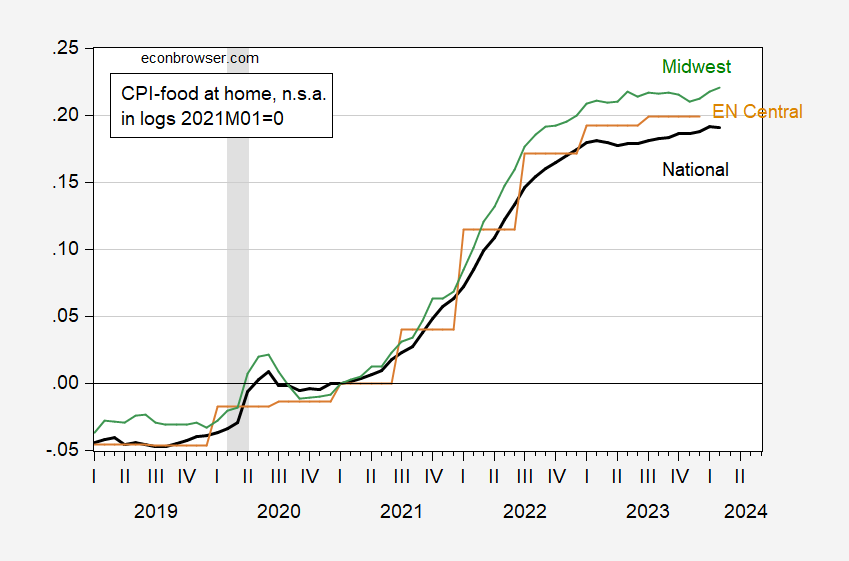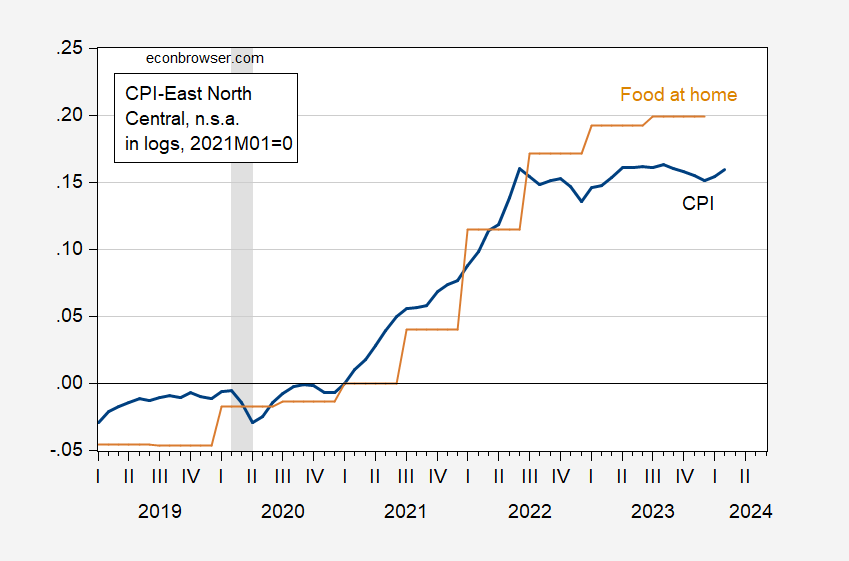That article prompted me to wondered whether Wisconsin’s grocery prices had moved up faster than the Nation’s. They have!
…“When Trump was president, there wasn’t inflation,” she said. “We could afford food.”
Affording food relies on both cost and income. We can kind of observe costs – although not specifically for Wisconsin. We can see them for East North Central (Wisconsin, Michigan, Illinois, Indiana, Ohio).
Figure 1 shows that food at home prices in East North Central have risen more than nationally, but less than the Midwest overall.
On the other hand, the cumulative gap between food prices and overall CPI is wider than at the national level.
In the last quarter of 2023, the gap was about 4.5 percentage points (i.e., from 2021M01 onward, food prices had risen 4.5 percentage points more than the overall price level). At the national level the corresponding gap was about 2.5 percentage points.
While Wisconsinites — well East North Central Midwesterners — have seen food prices rise, as of the second half of October 2023, Wisconsinites spent $49/week less on groceries than the national average of $270.
It’s also true that wages and salaries have increased over time, as compared to 2021. Food prices relative to per capita wages and salaries were as high in 2023Q1 as in 2020Q2. While they have since recovered, they are still lower in 2023Q3 (last data available) by about 6% relative to 2019Q4.
Why might prices have risen faster in East North Central (and Midwest) than nationally? I thought it might be grocery store concentration, but what little research I’ve seen (e.g., Cakir, et al., 2023) indicates an association between concentration (measured by a Herfindahl index) and price level, and not rate of change. So I don’t have a good answer here.


Dear Wisconsinites, ever heard of Shasta Cola??
Choose “Wisconsin” from the pull down menu:
https://www.shastapop.com/locate/
Sent with love from Uncle Moses.
After reading the article – I went out and checked in a couple grocery stores in Madison – store brands are running 30 to 60% less than branded food products. Yep – store brand sugary cola is a $1.50. My point being is that “value-oriented” grocery shopping is a having a field day right now – ALDI just announced plans to open 800 new stores across the United States by the end of 2028, Research shows that this causes other chains to lower prices. https://www.cbsnews.com/news/aldi-to-open-800-new-stores-by-2028/
I have been reading several of these grocery prices are high! lately. It is the new old white guy in diner in the Midwest says something about politics.
Why don’t they ever come to Madison and interview the shoppers at the Willy St. Food Coop? BTW – I love this quote in the article ” Longseth, a retired medical secretary, and her husband are still shopping the way they used to, she said. And she doesn’t plan to change her voting habits, either: She’ll support Biden again. “There’s never been any question about how I would vote in the election,” she said. “And no amount of inflation or bad news would change that.”
BTW – if you live in Sheboygan – why are you not shopping for meat at Miesfeld’s? https://miesfelds.com/
What we have here is partly a question of elasticities. And we know that short-term and long-term elasticities are not the same. Food price elasticities are thought to be lower than for goods in general – ya gotta eat – but one adjusts.
Recently General Mills CEO told analysts:
“As you look at the last 12 weeks, it’s pretty clear that elasticity – volume elasticities – have increased.”
https://www.just-food.com/news/general-mills-says-price-hikes-mostly-done-as-elasticity-increases/?cf-view&cf-closed
Looks like we may have gone from the short term to the long term.
One thing which I suspect influences price elasticity is income, and there has been an interesting development in the Northeast Central region:
https://fred.stlouisfed.org/graph/?g=1iBGN
In the aftermath of the Covid recession, that region has gone from a median income below the national average to above the national average.
How weird is it that Wisconsin drew James Madison U as an opponent in the big dance tournament?? If heavenly spirits can watch basketball games played here on our very sinful Earth, how much can we wager Prof Rosser will have courtside seats?? Which university’s jersey will Barkley be wearing?? Thoughts of his closer friends welcome.
The Fed’s Summary of Economic Projections is out. While the end-2024 median estimate for the funds rate is unchanged from December, the “dots” have clustered toward the bottom of the range of estimates, putting an additional cut this year within easy reach.
R* is now put at 0.6% rather than 0.5%, but we should ignore that, because Johnny said so.
Growth estimates for 2024-2026 have all been raised, though the longer-term average is unchanged at 1.8%. Maybe Fed economists have done what Goldman has done, taking into account the growth implications of increased immigration. The median estimate for the jobless rate is now 4.0% for end-2024, rather than 4.1%. That’s still just barely a recessionary signal by the Sahm rule, but GDP estimates no longer suggest recession. Lots of official estimates are blending recession signals with non-recessionary forecasts these days – so I guess “it’s different this time”.
From Alphaville’s Robin Wigglesworth
https://www.ft.com/content/96dc9516-22d4-42f1-834b-847a6ccc2b48
“Basically, Goldman Sachs thinks that immigration will short-circuit the Sahm Rule, which stipulates that a recession is in the mail when the three-month moving average of the US unemployment rate rises by half a percentage point off its 12-month low.”
“. . . The recent increase in the unemployment rate has been led by a higher unemployment rate amongst foreign-born workers, which itself likely reflects the combination of elevated immigration and a higher rate of unemployment amongst recent immigrants. This implies that the increase in unemployment over the last year mostly reflected an increase in labor supply from new immigrants, which is unlikely to trigger a vicious cycle of job loss, income loss and further unemployment that is typically associated with increases in the unemployment rate.”
Remember when RUDY tried to sneak Lev Parnas out of the country? Maybe this is why:
https://www.nbcnews.com/politics/joe-biden/lev-parnas-ex-giuliani-associate-testifies-allegations-bidens-are-fals-rcna144250
Lev Parnas, ex-Giuliani associate, testified allegations against Bidens are false and ‘spread by the Kremlin’
Parnas also called out Trump allies in Congress such as former Rep. Devin Nunes, R-Calif., and Sen. Ron Johnson, R-Wis., for spreading misinformation about the Bidens.
Ex-Rudy Giuliani associate Lev Parnas slammed former President Donald Trump and his associates for pushing what he said were false allegations against the Biden family during the House Oversight Committee’s hearing Wednesday in the GOP impeachment inquiry into President Joe Biden.
Parnas, a Ukrainian-American businessman who worked closely with former Trump attorney Giuliani in 2018 and 2019 to try to find damaging information on Joe Biden, appeared as a witness at the invitation of committee Democrats alongside Hunter Biden’s former business partners Tony Bobulinski and Jason Galanis.
“The American people have been lied to, by Donald Trump, Rudy Giuliani, and various cohorts of individuals in government and media positions,” Parnas said in his opening statement. “They created falsehoods to serve their own interests knowing it would undermine the strength of our nation.”
Parnas called out Trump allies in Congress such as former Rep. Devin Nunes, R-Calif., and Sen. Ron Johnson, R-Wis., as well as some prominent right-wing media figures for spreading misinformation about the Bidens.
“Congressman Pete Sessions, then-Congressman Devin Nunes, Senator Ron Johnson and many others understood they were pushing a false narrative,” he said. “The same goes for John Solomon, Sean Hannity and media personnel, particularly with Fox News, who use this narrative to manipulate the public ahead of the 2020 elections. Sadly, they are still doing this today as we approach the 2024 elections.”
Biden announces new rule for gas car emissions that could boost EV sector
Rule, hailed as historic step on climate crisis, will have slashed more than 7bn tons of carbon dioxide emissions by 2055
https://www.theguardian.com/us-news/2024/mar/20/biden-car-transportation-emission-regulation-pollution
Must read story. Kevin Drum has some must see graphs:
https://jabberwocking.com/new-epa-rules-cut-emissions-promote-sales-of-evs/